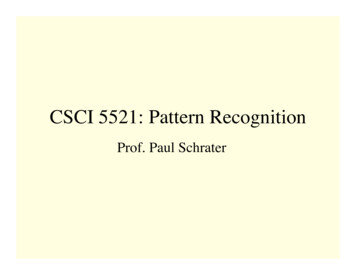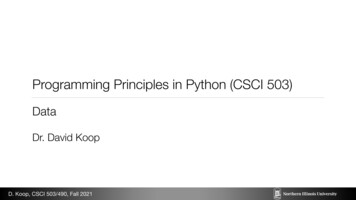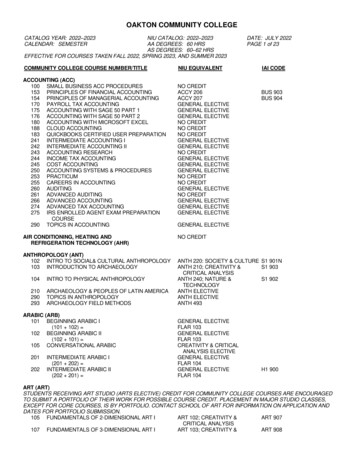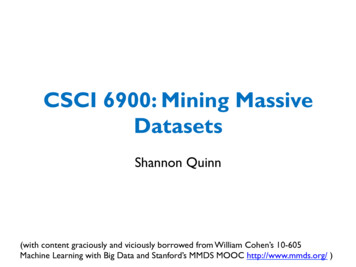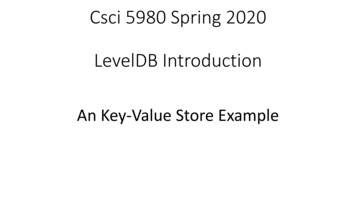
Transcription
Csci 5980 Spring 2020LevelDB IntroductionAn Key-Value Store Example
Projects Using LevelDB
LevelDB “LevelDB is an open source on-disk key-value storewritten by Google fellows Jeffrey Dean and SanjayGhemawat.” – Wikipedia “LevelDB is a light-weight, single-purpose library forpersistence with bindings to many platforms.” –leveldb.org
API Get, Put, Delete, Iterator (Range Query).
Key-Value Data Structures Hash table, Binary Tree, B -Tree"when writes are slow, defer them anddo them in batches” **Dennis G. Severance and Guy M. Lohman. 1976.
Log-structured Merge (LSM) TreeO’Neil, P., Cheng, E., Gawlick, D., & O’Neil, E. (1996).
Two Component LSM-Tree
K 1 Components LSM-Tree
Rolling Merge
From LSM-Tree to LevelDBLu, L., Pillai, T. S., Arpaci-Dusseau, A. C., & Arpaci-Dusseau, R. H. (2016).
LevelDB Data Structures Log file Memtable Immutable Memtable SSTable (file) Manifest file
Archival Storage
Outline Archival Storage- archival- backup vs archival Long-term data retention- architecture and technologies- cloud for archival- Self-contained Information Retention Format
What is archival storage? In computers, archival storageis storage for data that may not beactively needed but is kept forpossible future use or for recordkeeping purposes. Archival storage is often providedusing the same system as that usedfor backup storage. Typically,archival and backup storage can beretrieved using a restore process [1].
Health Insurance Portability andAccountability Act
An Archival Storage System A high-end computing environment includes a 132-petabytetape storage system that allows science and engineering usersto archive and retrieve important results quickly, reliably, andsecurely (NASA) 44 PB current unique data stored SGI
Backups and Archives Backups are for recovery Archives are for discovery and preservation
Storage Perspective: archival application Data archiving is the process of moving data that is no longer activelyused to a separate data storage device for long-term retention. Most are write once, but if needed, it is crucial
Backup and archiving at a glance
Backup and disaster recovery requirements High media capacity High-performance read/write streaming Low storage cost per GB
Archive requirements Data authenticity Extended media longevity High-performance random read access Low total cost of ownership
Long Term Data Retention – 5 KeyConsiderations1. Business and Regulatory Requirements Demand a Long-term Plan2. Manage and Contain Your Total Cost of Ownership (TCO)3. Encrypt Your Data for Secure Long-term Retention4. Weigh the Environmental Impacts and Minimize Power and CoolingCosts5. Simplify Management of the Entire Solution
Disk scrubbing Drives are periodically accessed to detect drive failure.By scrubbing all of the data stored on all of the disks,we can detect block failures and compensate for themby rebuilding the affected blocks.
The two-tiered data retentionThe two-tiered architecture enables administrators todeploy a short-term active tier for fast ingest of backupdata, and a retention tier for cost-effective long-termbackup retention [7] (Data Domain).
The Emergence of a New Architecture for Longterm Data Retention By taking advantage of the tape layer, use cases likearchiving, long-term retention and tiered storage (where70 % of the data is stale) can live on a low-cost storagemedium like tape. By leveraging Flash/SSD, each use case doesn’t suffer thetypical tape performance barriers.
File SystemsFilesDirectoriesFile system implementationExample file systems26
Long-term Information Storage1. Must store large amounts of data2. Information stored must survive the terminationof the process using it3. Multiple processes must be able to access theinformation concurrently27
File NamingTypical file extensions.28
File Structure Three kinds of files byte sequence record sequence tree29
File Types(a) An executable file (b) An archive30
File Access Sequential access read all bytes/records from the beginning cannot jump around, could rewind or back up convenient when medium was mag tape Random access bytes/records read in any order essential for data base systems read can be move file marker (seek), then read or read and then move file marker31
File AttributesPossible file attributes32
File Operations1. Create2. Delete3. Open4. Close5. Read6. Write7. Append8. Seek9. Get attributes10.Set Attributes11.Rename33
An Example Program Using File System Calls (1/2)34
An Example Program Using File System Calls (2/2)35
Memory-Mapped Files(a) Segmented process before mapping filesinto its address space(b) Process after mappingexisting file abc into one segmentcreating new segment for xyz36
DirectoriesSingle-Level Directory Systems A single level directory system contains 4 files owned by 3 different people, A, B, and C37
Cloud Storage and Big Data OpenStack VM vs. Container Durability, Reliability and Availability Private vs. Public Cloud
nerationQoS-aware IO callsFile SystemQoS to hintsSCSI Device DriverI/O RequestsSCSI HintsGeneric Block LayerBuildingHintsMappingTablePersistent Data StructuresData BlocksClassifierbioLogical VolumeCache BufferCloudObjectsPrefetchDM Table Hints MappingTableLogical Volume vol1Device MapperLinear devicesSSDHDDThin ClientCloud
Parallel File Systems and IOWorkload Characterization
Why Is This Important? Workload Characterization Key to performance analysis of storage subsystems. Key to the implementation of simulators, as captured/synthesized workloads are keyinputs. Key Issues Lack of widely available tool sets to capture file system level workloads for parallelfile systems Lack of methods to characterize parallel workloads (for parallel file systems) Lack of methods to synthesize workloads accurately at all levels (Block, File , etc) Understanding of how existing workloads scale in the exascale regime is lacking
Goals and Objectives A detailed understanding and survey of existing methods in file systemtracing, trace replaying, visualization, synthetic workload generators at thefile system input levels, and existing mathematical models Tools , techniques and methods to analyze parallel file system input traces(require to know more about OS, meta-data server, and applications) Models to characterize the above workloads traces (Using statistical andanalytical methods) Synthetic workload generation at the parallel file system input level – whichwill be used as inputs to the simulator. Understanding of the interactions of workloads at the file system level andmaking the file system aware of the workloads
Block-Level Workload CharacterizationStorage system performance cannot be determined by the system alone.IO Workload (W)Operation Disk Address Size Time PSystemPerformanceSStorageSystemWIO WorkloadSystem Performance (P)Throughput (MB/S)IOPS (operations/s)Latency (s)StorageStorage SystemSystem (S)(S) P f(S, W)PossibleWorkload SpaceReal WorkloadSpace Improving system for all possibleworkload space is difficult. If we know the real workload spacewe can improve performance moreefficiently.
Framework of I/O Workload rametersComparison 2Arrival pattern, File/Dataaccess pattern in theform of parametersComparison 1Changes toapplications and /orsystem ( either host orstorage)WorkloadgenerationReplayedtraceReplay onsame/differentstorage systemReplay byworkloadreplayerComparison 3Synthetic traceActionOutput
Tiered Storage Research
Data Migration, Duplication, andDeduplication Tiered Storage Management When a file is accessed, we may want to move related datalevel up to a faster storage provisioning potential near futureaccess requests Duplication level optimal for a long-term storage Dedup algorithm and how to preserve it long-term (need tomake sure we know how to get the data back) How to find the right balance between duplication and dedup?How do we validate that data is stored the we think it is? Imperfect dedup may be what we are looking for. However,what do we do if we want to have different levels of backup fordifferent data.
DNA-Storage
BackgroundDNA es/BasicsPresentation.pdf
BackgroundPCR: polymerase chain reaction PCR: a method for exponentially amplifying the concentration of selectedsequences of DNA within a pool. Primers: The DNA sequencing primers are short synthetic strands thatdefine the beginning and end of the region to be amplified.
https://en.wikipedia.org/wiki/Polymerase chain reaction
BackgroundDNA Synthesis Arbitrary single-strand DNA sequences can be synthesized chemically,nucleotide by nucleotide. Synthesizing error limits the size of the oligonucleotides ( 200nucleotides). truncated byproducts Parallel synthesize: 10 5 different oligonucleotides.
BackgroundDNA sequencing The DNA strand of interest serves as a template for PCR. Fluorescent nucleotides are used during this synthesis process. Read out the complement sequence optically. Read error. ( 1%)
A DNA Storage System Very dense and durable archival storage with access times of many hours to days. DNA synthesis and sequencing can be made arbitrarily parallel, making thenecessary read and write bandwidths attainable.
Overview basic unit: DNA strand that is roughly 100-200 nucleotides long, capable of storing50-100 bits total. data object: maps to a very large number of DNA strands. The DNA strands will be stored in pools stochastic spatial organization structured addressing: impossible address: embedded into the data stored in a strand
Interface and Addressing Object Store: Put(key, value) / Get(key). Random access: mapping a key to a pair of PCR primers. write: primers are added to the strands read: those same primers are used in PCR to amplify only the strands with the desired keys. Separating the DNA strands into a collection of pools: primers reacts. the chances of the sample contains all the desired data.
System Operation
Encoding Base 4 encoding: 00, 01, 10, 11 A, T, G, C. Error prone: synthesis, PCR, sequencing (substitutions, insertions, and deletions of nucleotides) Base 3 Huffman code rotation code
Data Format
Adding RedundancyGoldman EncodingXOR Encoding
Why Is This Important? Workload Characterization Key to performance analysis of storage subsystems. Key to the implementation of simulators, as captured/synthesized workloads are key inputs. Key Issues Lack of widely available tool sets to capture file system level workloads for parallel file systems Lack of methods to characterize parallel workloads (for parallel file systems)






